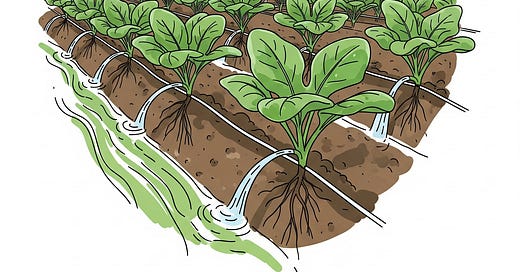Calculating Crop Water Needs: Essential for Efficient Irrigation
No More Guesswork: Precisely Water Your Crops for Better Yields and a Greener Planet
Water is the lifeblood of agriculture, but applying it efficiently is key to sustainable farming.
Giving your crops too much or too little water can lead to problems, from wasted resources to reduced yields.
Understanding precisely how much water your plants need is the first step towards truly efficient irrigation.
Why is Knowing Crop Water Needs So Important?
Saves Water: Prevents over-irrigation, conserving this precious resource.
Optimizes Plant Health: Ensures plants get the exact amount of water for optimal growth, avoiding stress from too little or too much.
Boosts Yields: Properly watered crops are healthier and more productive, leading to better harvests.
Reduces Costs: Less water waste means lower pumping costs and reduced energy consumption.
Minimizes Runoff and Leaching: Prevents excess water from carrying away valuable nutrients or contributing to environmental pollution.
Supports Sustainability: A core practice for eco-conscious farming and resource stewardship.
Key Factors Influencing Crop Water Needs:
Crop Type: Different plants have different water demands (e.g., rice needs more water than chickpeas).
Growth Stage: A crop's water needs change throughout its life cycle (e.g., flowering often requires more water than early growth).
Climate/Weather:
Temperature: Higher temperatures increase water use.
Humidity: Lower humidity increases water loss from plants and soil.
Wind Speed: Windy conditions increase evaporation.
Solar Radiation (Sunlight): More intense sunlight means more water use.
Soil Type:
Sandy soils: Hold less water, requiring more frequent, smaller irrigations.
Clay soils: Hold more water, allowing for less frequent, larger irrigations.
Effective Rainfall: The amount of rainfall that actually benefits the crop and is stored in the soil.
How is Crop Water Need (ETc) Calculated Simply?
The most common way to estimate crop water needs is through a concept called Evapotranspiration (ETc). This is the total amount of water lost from the soil surface by evaporation and from the plants by transpiration.
A common simple formula often used is: ETc = ETo x Kc
ETo (Reference Evapotranspiration): This is the estimated water use of a standard reference crop (like grass) under ideal conditions, usually calculated from weather data (temperature, humidity, wind, sunlight). You can often find ETo data for your region from local agricultural extension services or online tools.
Kc (Crop Coefficient): This is a specific factor for each crop type and its growth stage. It adjusts the ETo to reflect the actual water use of your specific crop. Kc values are available in tables from agricultural research organizations (like FAO).
Example (Simplified):
If your ETo for a given period is 5 mm/day.
And your crop (at a specific growth stage) has a Kc of 0.8.
Then, ETc = 5 mm/day * 0.8 = 4 mm/day. This means your crop needs about 4 millimeters of water per day.
Tips for Implementing Water Need Calculations:
Consult Local Experts: Your local agricultural extension office can provide region-specific ETo data and Kc values for common crops.
Use Online Tools/Apps: Many agricultural apps and online calculators can help you estimate crop water needs.
Monitor Your Fields: Combine calculations with field observations (e.g., wilting leaves) and soil moisture sensors for best results.
Adjust for Rainfall: Subtract effective rainfall from your calculated ETc to determine your net irrigation requirement.
Conclusion: Empowering Farmers, Protecting Our Planet
At Farmer's Chat, we believe that informed decisions are the bedrock of sustainable agriculture. Calculating crop water needs is a fundamental practice that empowers farmers to manage water resources wisely, leading to more resilient farms, improved yields, and a healthier planet. As a non-profit initiative, we are doing this for the betterment of farmers, because farmers are the backbone of civilization. By adopting precise irrigation strategies, you are not just growing crops; you are cultivating a sustainable future for all.
Join our community and explore more ways to farm smarter, not harder! Visit our website for free learning resources and connect with us on social media to share your experiences and insights. Your support helps us continue our vital mission of supporting farmers and protecting our environment.
#CropWaterNeeds #EfficientIrrigation #WaterConservation #SustainableAgriculture #PrecisionFarming #Evapotranspiration #FarmManagement #Agronomy #SmartFarming #ResourceManagement #FarmersChat #Farmers #Chat #VishalRajput #Agriculture





Does the quality of the irrigation water (e.g., salinity, presence of contaminants, or hardness) affect these calculations or the overall efficiency of irrigation?
In some contexts, for example, highly saline water can reduce plant uptake or require higher volumes to prevent soil accumulation.
It would be interesting to know if and how these aspects are integrated into sustainable irrigation strategies.
Thanks for the article and for raising awareness on such essential topics.